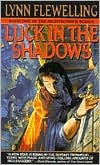Saturday, May 02, 2009
The Marshall Plan 3: Sections
"Sections" as described in The Marshall Plan are like scenes, and some reviewers equate the two. However, they are not necessarily the same thing. Let me explain by using a stage play as an example.
Imagine a play begins with two characters walking out on stage, talking, then walking off. The audience would think, "Gee, that was the first scene". They'd probably be correct about that. Then, a third character comes out on stage and delivers a monologue, letting the audience hear his thoughts, and he walks off. Most people would regard that as Scene Two, and they'd probably be right. (It would depend on where the playwright chose to make the scene breaks).
But, what if two characters came out on stage, talked to each other, then stayed on stage. A moment later, the doorbell sounded, and that third character entered and talked to the other two? Was that one scene, or two?
Of course, it would depend on where the playwright chose to create scene breaks. He/she might have kept it all as one scene, but he/she might also have put a scene break just before the doorbell sounds. In that case, Scene One would involve two characters, and Scene Two would involve the same two characters plus a third character.
Playwrights typically break larger scenes into smaller scenes because it helps the people who will perform their plays. The director can say, "Let's rehearse Scene One," and everyone will know that only two actors are needed on stage. The third actor can hang out in his dressing room with the rest of the cast and brag about the reviews of his last performance. But, if the director calls for a rehearsal of Scene Two, then everybody knows that three actors are needed, two on stage and one hiding behind the door, ready to walk out on stage.
Are sections scenes? It's sort of like the example above. A section could be a scene, or a part of a scene, but a section clearly stands on its own as a distinct unit. Scenes are made up of sections, always at least one, possibly more. Sections are the basic building blocks.
So, what is a section?
A section is just that -- a section of continuous text, made up of paragraphs, maybe some dialog, lasting something like 1250 words. That's just long enough that the reader can get pulled into the story and experience something significant and meaningful, and just short enough that the reader can do this within a matter of minutes, rather than needing an hour or two. By breaking your novel down into shorter sections, you allow your readers to focus, read, get something out of it, then look up and deal with whatever distraction is pulling them away from their reading, before focusing again and tackling the next section. You can make one section into a stand-alone scene, or you can join two sections together into one larger scene, but each section will still stand on its own, a "mini-scene" that is satisfying and complete in its own right.
In the Marshall Plan, there are two kinds of sections: action and reaction. Most sections are action sections in which one point-of-view character acts to meet one specific goal. Standing in the way is one opposition character who generates one or more obstacles, and the matter is resolved in some appropriate way by the end of the section. For the protagonist, this will be in some kind of failure. For the antagonist, the section will end in success. The antagonist's success translates as failure for the protagonist, and vice versa. Each action section ends with the setting of a new goal, although that goal is usually not expressed (the POV character will think it, but the reader will not read about it until the next section). The only time a new goal is not set is when the setback was so great that the POV character needs more time to deal with the emotions that arose from the failure. In this instance, the action section is followed by a reaction section.
In the reaction section, the POV character deals first with the emotions that resulted from the prior setback, then thinks the situation over and determines his/her next course of action (new goal). Hence, a reaction section has two key phases: "emotional" and "rational".
When you divide a novel into sections, you break it down into smaller, more manageable chunks. When you map out the sections, using the template given in The Marshall Plan (and fully automated for you if you use the new software), then you produce a series of short steps that you can follow with the sort of clarity and focus that those who don't plan can only dream of. The first time I fully plotted a novel using The Marshall Plan software, I was able to write 21,000 words of new material in one day. My previous record was about 9,000 words. I had always used much longer scenes, typically 2500 - 3,000 words, sometimes 5,000 - 10,000 words long. Far too long. When I worked with smaller sections, averaging about 1250 words, it felt like an enormous weight had been lifted off my shoulders. I could focus like never before, knowing that I had to be very concise, very focused, to deliver the drama I had planned for in such a short space. I sought the best way to dramatize the key struggle (goal-conflict-resolution). I didn't have to wonder what the goal was, what the basic struggle was, or how the section was supposed to end. It was all laid out for me, thanks to careful planning. What a difference!
As followers of my blog know, I plan extensively as a matter of habit. But the Marshall Plan's constant emphasis on shorter, more manageable sections, on goal, complication, failure and new goal kept me on track like never before. The abstract became concrete. The Marshall Plan helped me to achieve a remarkable degree of clarity for each and every section, each and every scene, of the entire novel! The novel practically wrote itself since the planning had included the key pieces that drove each step of the story forward.
Adrian
Subscribe to:
Post Comments (Atom)








No comments:
Post a Comment